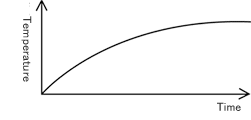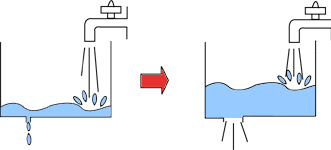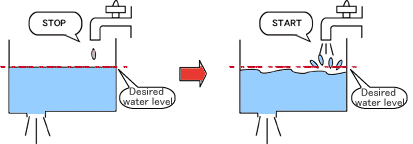

Top of Products > Solder-Aid > HIKARU'S DIARY ON LEARNING TO SOLDER > EPISODE 2 : "Heat quantity is like water."



To make it easier to understand, we will classify soldering irons into two types: "Temperature saturation type" and "Temperature control type".
It has become harder to understand. What is the difference between these two types?
First, I'll talk about the "Temperature saturation type". The maximum amount of current flows through this type of soldering iron; In other words, it is always "ON".
I see! Then, the iron temperature must increase without limit. I don't want such dangerous soldering iron.
Ha-ha-ha (Laughing). Now, look at this graph.

After turning on the temperature saturation type soldering iron, the iron temperature will increase to a certain temperature and then will stop increasing. This temperature is called the "saturation temperature", which is the indicated operating temperature of the soldering iron.
You mean the iron temperature will not increase without limit. Why?

Please look at this drawing.

Assuming that this water tank is filled with water at a constant rate, water is stored in the tank. But, this tank has a hole and the hole becomes larger as the water level increases. At the beginning, the water level smoothly increases because the hole is still small. But, as the water level becomes high, the hole becomes larger, causing a larger quantity of water to go out of the tank. In this condition, the water level will not increase considerably. What do you think the water level will become then?
Let me see. As the quantity of outgoing water increases...? I got it! Since the quantity of incoming water becomes equal to that of outgoing water, the water level will not increase any more.
That's right! The temperature saturation type soldering iron is based on the same principle. We can say that the water tank is the soldering tip, the stored water is the heat stored in the soldering tip (amount of heat storage), the incoming water is the heat that the heater supplies to the soldering tip, and the water going out of the hole is the heat radiated from the soldering tip. As the difference between the ambient temperature and the soldering tip temperature becomes large, the amount of radiated heat increases, and the temperature remains constant when the amount of stored heat is balanced with the amount of radiated heat. Such a condition is called thermal equilibrium condition.
I see. I'm starting to understand now.
Okay, now I'll explain the "Temperature control type". This type of soldering iron forcefully controls the iron temperature so that the temperature rise will stop before the saturation temperature.

I'll explain it using the water tank example we talked about earlier: The principle of the temperature control type is the same as that of the temperature saturation type, in that the water level increases after the faucet is fully opened (turned ON). But, the difference is that the faucet is closed (turned OFF) as soon as the water level reaches the desired level. Then, when the water level lowers, the faucet is fully opened (turned ON) again and closed (turned OFF) when the desired level is reached. Does that make sense?
I understand. The desired water level is the temperature indicated on the soldering iron!
That's right. There is another type of soldering iron, called the "station type". It provides a separate temperature control unit, but uses the same principle as the temperature control types. But, since the station type soldering iron can set the soldering tip to a desired temperature, it is applicable to a wide range of soldering conditions, from those requiring a large amount of heat to those inhibiting a large amount of heat.
Hmm. You mean that there is a difference between soldering irons with the same temperature rating of 320℃. That is, the temperature saturation type reaches 320℃ at its full capacity, but the temperature control type reaches 320℃ with remaining capacity and allows a further temperature rise.
You have understood it thoroughly. That's it. The advantage of the temperature control type is that it enables accurate temperature control and that the heater's "W" value is large. Therefore, the temperature control type can reduce the time required for the soldering tip to reach a set temperature and the time to recover set temparature. Thus, this type of soldering iron is useful for continuous work. But, the temperature saturation type can work well if you need neither accurate temperature control nor continuous work.
Which type of soldering iron is right for me?
For wiring soldering, I recommend "HAKKO RED" rated at 20 to 40W. But, if you intend to use the soldering iron for precision electronic components such as ICs in the future, "HAKKO DASH" rated at 15W may be preferable.
Hmm, Well, I'll take the "HAKKO DASH" 15W. I suppose that it can be used for various purposes. Can you suggest what I should buy in addition to this?
Well, you need to have an iron holder since it's very dangerous to put heated soldering iron on the workbench directly. This iron holder has a cleaning sponge which is convenient to remove excess solder from the tip. And, I'd like to recommend desoldering braid (HAKKO WICK) which is useful to correct bad soldering. You can remove solder with it.
Then, which solder wire do you recommend?
This HEXSOL solder should be fine. The ideal diameter of solder wire is 0.6 to 1.0mm for electronic handicrafts, and 1.2 to 2.0mm for metal working. So, I believe solder diameter of 0.8mm or 1.0mm should be OK in your case.
Then, I will take this 1.0mm solder. By the way, do you have time from now ?
You won't ask me to come with you, will you?
How do you know that?
‐Now, Hikaru and Mr. Tanaka are heading to Hikaru's home.